A lance is a long thrusting spear designed to be used by a mounted warrior or cavalry soldier (lancer). In ancient and medieval warfare, it evolved into the leading weapon in cavalry charges, and was unsuited for throwing or for repeated thrusting, unlike similar weapons of the javelin and pike family typically used by infantry. Lances were often equipped with a vamplate, a small circular plate to prevent the hand sliding up the shaft upon impact, and beginning in the late 14th century, they were used in conjunction with a lance rest attached to the breastplate. Though best known as a military and sporting weapon carried by European knights and men-at-arms, the use of lances was widespread throughout East Asia, the Middle East, and North Africa wherever suitable mounts were available. Lancers of the medieval period also carried secondary weapons such as swords, battle axes, war hammers, maces, and daggers for use in hand-to-hand combat, since the lance was often a one-use-per-engagement weapon; assuming the lance survived the initial impact without breaking, it was often too long, heavy, and slow to be effective against opponents in a melee.

Norman cavalry attacks the Anglo-Saxon shield wall at the Battle of Hastings as depicted in the Bayeux Tapestry. The lances are held with a one-handed over-the-head grip.
Lance head, Warring States period
Warring States lance head (pi)
A lance head from the reenactment of the Eglinton Tournament (1839)
A spear is a polearm consisting of a shaft, usually of wood, with a pointed head. The head may be simply the sharpened end of the shaft itself, as is the case with fire hardened spears, or it may be made of a more durable material fastened to the shaft, such as bone, flint, obsidian, copper, bronze, iron, or steel. The most common design for hunting and/or warfare, since ancient times has incorporated a metal spearhead shaped like a triangle, diamond, or leaf. The heads of fishing spears usually feature multiple sharp points, with or without barbs.
The Clacton Spear, a spear point from about 400,000 years ago, and the oldest known spear, Natural History Museum, London
Hunting spear and knife, from Mesa Verde National Park
Athenian warrior wielding a spear in battle
Re-enactor outfitted as a Late Roman legionary carrying a pilum








